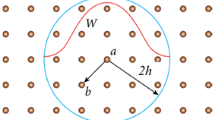Abstract
Mitral valve repair is a complex operation, in which the functionality of incompetent mitral valve is reconstructed by surgical techniques. Simulation-based surgical planning system, allowing surgeons to simulate and compare potential repair strategies, could greatly improve surgical outcomes. This paper presents a practical computational framework, combining the Total Lagrangian Explicit Dynamics Finite Element Method (TLED FEM) and Smoothed Particle Hydrodynamics (SPH), to solve the interaction problem of blood and immersed mitral valves. With this completed pipeline, we can not only predict the mechanical behavior of mitral valve, but also analyze the transvalvular pressures distributed on valve leaflets. The experimental results demonstrate that our method has the potential to be applied in surgical planning simulator of mitral valve repair.
Access this chapter
Tax calculation will be finalised at checkout
Purchases are for personal use only
Similar content being viewed by others
References
Iung B, Vahanian A (2011) Epidemiology of valvular heart disease in the adult. Nat Rev Cardiol 8(3):162–172
Vahanian A, Baumgartner H, Bax J, Butchart E, Dion R, Filippatos G, Flachskampf F, Hall R, Iung B, Kasprzak J et al (2007) Guidelines on the management of valvular heart disease. Eur Heart J 28(2):230–268
Gammie JS, OBrien SM, Griffith BP, Ferguson TB, Peterson ED (2007) Influence of hospital procedural volume on care process and mortality for patients undergoing elective surgery for mitral regurgitation. Circulation 115(7):881–887
Mansi T, Voigt I, Georgescu B, Zheng X, Mengue EA, Hackl M, Ionasec RI, Noack T, Seeburger J, Comaniciu D (2012) An integrated framework for finite-element modeling of mitral valve biomechanics from medical images: application to mitralclip intervention planning. Med Image Anal 16(7):1330–1346
Kunzelman K, Einstein DR, Cochran R (2007) Fluid–structure interaction models of the mitral valve: function in normal and pathological states. Philos Trans R Soc Lond B Biol Sci 362(1484):1393–1406
Votta E, Le TB, Stevanella M, Fusini L, Caiani EG, Redaelli A, Sotiropoulos F (2013) Toward patient-specific simulations of cardiac valves: state-of-the-art and future directions. J Biomech 46(2):217–228
Stevanella M, Maffessanti F, Conti CA, Votta E, Arnoldi A, Lombardi M, Parodi O, Caiani EG, Redaelli A (2011) Mitral valve patient-specific finite element modeling from cardiac MRI: application to an annuloplasty procedure. Cardiovasc Eng Technol 2(2):66–76
Xu C, Jassar AS, Nathan DP, Eperjesi TJ, Brinster CJ, Levack MM, Vergnat M, Gorman RC, Gorman JH, Jackson BM (2012) Augmented mitral valve leaflet area decreases leaflet stress: a finite element simulation. Ann Thorac Surg 93(4):1141–1145
Hammer PE, Pedro J, Howe RD (2011) Anisotropic mass-spring method accurately simulates mitral valve closure from image-based models. In: Functional imaging and modeling of the heart. Springer, Berlin, pp 233–240
Hammer PE, Sacks MS, Pedro J, Howe RD (2011) Mass spring model for simulation of heart valve tissue mechanical behavior. Ann Biomed Eng 39(6):1668–1679
Hammer PE, Chen PC, Pedro J, Howe RD (2012) Computational model of aortic valve surgical repair using grafted pericardium. J Biomech 45(7):1199–1204
Griffith BE (2012) Immersed boundary model of aortic heart valve dynamics with physiological driving and loading conditions. Int J Numer Method Biomed Eng 28(3):317–345
Le TB, Sotiropoulos F (2013) Fluid–structure interaction of an aortic heart valve prosthesis driven by an animated anatomic left ventricle. J Comput Phys 244:41–62
Einstein DR, Pin FD, Jiao X et al (2010) Fluid-structure interactions of the mitral valve and left heart: comprehensive strategies, past, present and future. Int J Numer Methods Eng 26(3-4):348–380
Lau KD, Diaz V, Scambler P et al (2010) Mitral valve dynamics in structural and fluid–structure interaction models. Med Eng Phys 32(9):1057–1064
Mittal R, Seo JH, Vedula V et al (2016) Computational modeling of cardiac hemodynamics: current status and future outlook. J Comput Phys 305:1065–1082
Otani T, Alissa A, Pourmorteza A et al (2016) A computational framework for personalized blood flow analysis in the human left atrium. Ann Biomed Eng 44:3284–3294
Miller K, Joldes G, Lance D, Wittek A (2007) Total Lagrangian explicit dynamics finite element algorithm for computing soft tissue deformation. Commun Numer Methods Eng 23(2):121–134
Monaghan JJ (2005) Smoothed particle hydrodynamics. Rep Prog Phys 68(8):1703
Nesme M, Kry PG, Jerabkova L et al (2009) Preserving topology and elasticity for embedded deformable models. ACM Trans Graph 28(3):52
Poston T, Wong TT, Heng PA (1998) Multiresolution isosurface extraction with adaptive skeleton climbing. Comput Graphics Forum 17(3):137–147. https://doi.org/10.1111/1467-8659.00261
Tao J, Schaefer S, Warren J (2005) Mean value coordinates for closed triangular meshes. ACM Trans Graph 24:561–566
Peskin CS (2002) The immersed boundary method. Acta Numer 11:479–517
Su B, San Tan R, Le Tan J et al (2016) Cardiac MRI based numerical modeling of left ventricular fluid dynamics with mitral valve incorporated. J Biomech 49(7):1199–1205
Acknowledgments
The work is supported by grants from Gongdong Natural Science Foundation Project (No. 2016A030313047), Shenzhen Science and Technology Program (No.JCYJ20160429190300857), the Science and Technology Plan Project of Guangzhou (No.201704020141), and National Natural Science Foundation of China (No. 81601576).
Author information
Authors and Affiliations
Editor information
Editors and Affiliations
Rights and permissions
Copyright information
© 2019 Springer International Publishing AG, part of Springer Nature
About this paper
Cite this paper
Si, W., Liao, X., Qin, J., Heng, P.A. (2019). Computational Modeling of Fluid–Structure Interaction Between Blood Flow and Mitral Valve. In: Nielsen, P., Wittek, A., Miller, K., Doyle, B., Joldes, G., Nash, M. (eds) Computational Biomechanics for Medicine. Springer, Cham. https://doi.org/10.1007/978-3-319-75589-2_4
Download citation
DOI: https://doi.org/10.1007/978-3-319-75589-2_4
Published:
Publisher Name: Springer, Cham
Print ISBN: 978-3-319-75588-5
Online ISBN: 978-3-319-75589-2
eBook Packages: EngineeringEngineering (R0)




